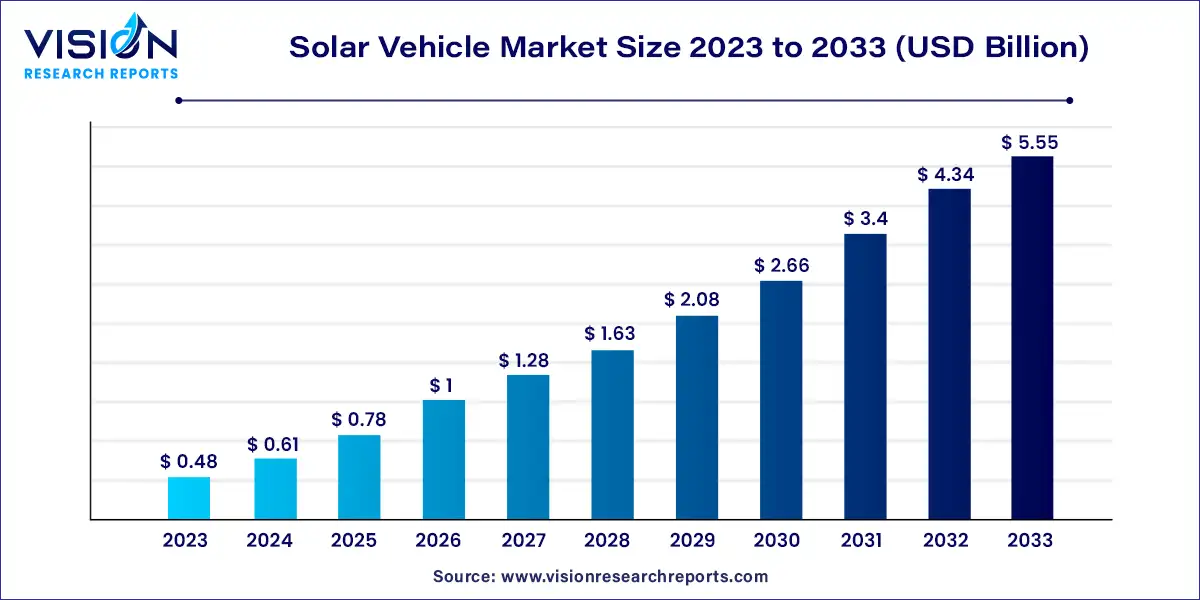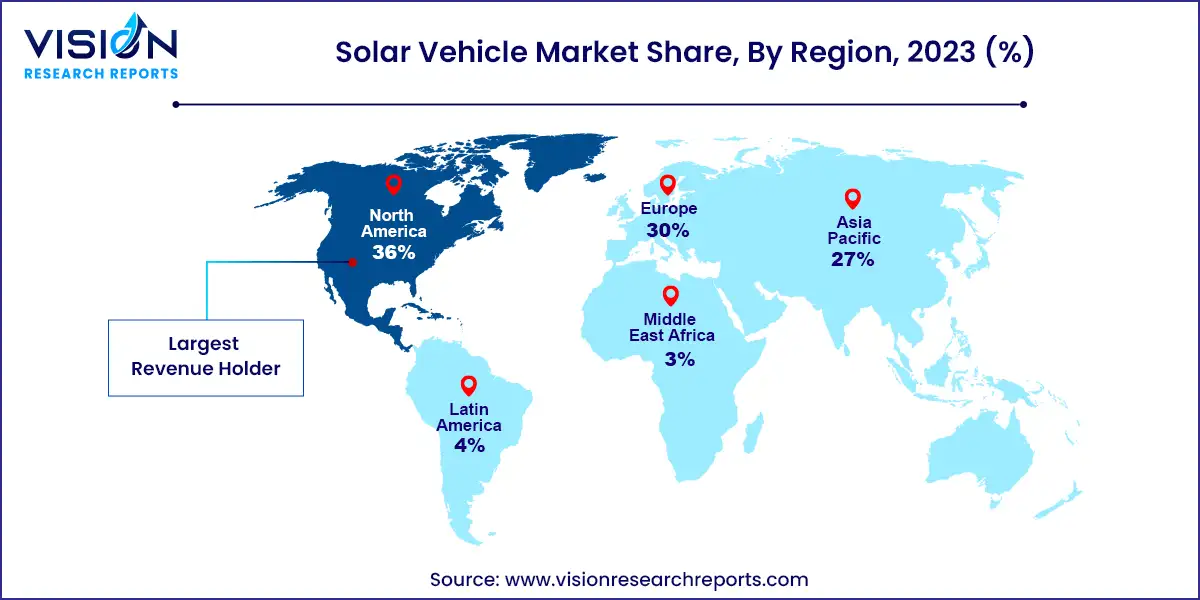The global solar vehicle market size was valued at USD 0.48 billion in 2023 and it is predicted to surpass around USD 5.55 billion by 2033 with a CAGR of 27.73% from 2024 to 2033. Solar vehicles represent an innovative step toward sustainable transportation by harnessing energy from the sun to power various vehicle types, including cars, buses, and even bicycles. These vehicles are equipped with photovoltaic cells that convert sunlight into electricity, which then powers the electric motor. As concerns about climate change and fossil fuel depletion grow, solar vehicles offer a promising solution by providing clean, renewable energy for transportation.

The growth of the solar vehicle market is primarily driven by an increasing emphasis on sustainable and eco-friendly transportation solutions, along with rising environmental concerns worldwide. As governments implement stricter emissions regulations and offer incentives for clean energy adoption, the demand for solar-powered vehicles is accelerating. Technological advancements in photovoltaic cells and energy storage systems have improved the efficiency and range of solar vehicles, making them more viable for everyday use. Additionally, growing consumer awareness of the environmental impact of fossil fuels and the desire for energy independence are further fueling the adoption of solar vehicles, paving the way for a greener future in the automotive industry.
1. Lightyear One
Overview: Lightyear is a Dutch automotive company that has developed the Lightyear One, a high-performance solar-powered electric car. This vehicle integrates solar panels directly into its design, aiming to reduce dependency on external charging and enhance sustainability.
Implementation:
Outcomes:
2. Sono Motors Sion
Overview: Sono Motors, a German startup, focuses on producing affordable solar-powered vehicles. The Sion model integrates solar panels into the car's bodywork, aiming to provide a practical and cost-effective solar vehicle option.
Implementation:
Outcomes:
North America led the global market in 2023, accounting for 36% of global revenue. The region's robust growth is attributed to strong government support, heightened environmental awareness, and technological advancements. Efforts to reduce carbon emissions and promote renewable energy sources are accelerating the adoption of solar vehicles in North America.
| Attribute | North America |
| Market Value | USD 0.17 Billion |
| Growth Rate | 27.73% CAGR |
| Projected Value | USD 1.99 Billion |
Europe is set for substantial growth from 2024 to 2033, driven by a commitment to reducing greenhouse gas emissions. European countries are investing significantly in renewable energy solutions, which is boosting the adoption of solar vehicles in the region.

Asia Pacific is expected to see significant growth from 2024 to 2033. Rapid urbanization, increasing environmental concerns, and supportive government policies are driving the market in this region. Major investments in solar technology and infrastructure by countries such as China, Japan, and India are promoting green transportation and fueling regional market growth.
The passenger cars segment led the solar vehicle market in 2023, capturing 41% of the global revenue. This segment's growth is fueled by rising consumer demand for eco-friendly transportation solutions. The increasing adoption of solar passenger cars is supported by advancements in solar technology and favorable government policies promoting sustainable transportation. Consequently, passenger cars are expected to continue leading the market through 2033.
The two-wheelers segment is projected to experience significant growth from 2024 to 2033. As concerns about climate change intensify, consumers are shifting towards clean energy alternatives from traditional fuel-based two-wheelers. This shift, particularly in densely populated areas, is driving the growth of solar two-wheelers. Additionally, innovations in lightweight solar panels and improved battery performance are accelerating the adoption of solar-powered two-wheelers.
In 2023, lithium-ion batteries dominated the solar vehicle market, holding the largest revenue share. Their high energy density, extended lifecycle, and improved efficiency contribute to their widespread adoption. Continuous advancements in lithium-ion battery technology enhance vehicle performance and reduce costs, ensuring the segment's leading position in the market.
The lead-acid battery segment is expected to grow significantly from 2024 to 2033. Despite being an older technology, lead-acid batteries are valued for their reliability and cost-effectiveness. Recent enhancements in lead-acid battery efficiency and sustainability, along with rising demand for eco-friendly solar vehicles, are driving this segment's growth. Advances in recycling processes have also improved the environmental impact of lead-acid batteries, maintaining their viability for many solar vehicle manufacturers.
The monocrystalline solar panel segment led the market in revenue share in 2023, thanks to its higher efficiency and superior performance in low-light conditions. These panels are favored for their durability and high power output, making them a preferred choice for solar vehicles. Ongoing innovations and decreasing costs are expected to drive the growth of monocrystalline panels through 2033.
The polycrystalline solar panel segment is anticipated to grow the fastest from 2024 to 2033. Although less efficient than monocrystalline panels, polycrystalline panels offer a more cost-effective and easier-to-manufacture alternative. The increasing demand for affordable solar vehicles and advancements in polycrystalline technology are driving this segment's rapid growth.
By Type
By Battery
By Solar Panel
By Region
 Cross-segment Market Size and Analysis for
Mentioned Segments
Cross-segment Market Size and Analysis for
Mentioned Segments
 Additional Company Profiles (Upto 5 With No Cost)
Additional Company Profiles (Upto 5 With No Cost)
 Additional Countries (Apart From Mentioned Countries)
Additional Countries (Apart From Mentioned Countries)
 Country/Region-specific Report
Country/Region-specific Report
 Go To Market Strategy
Go To Market Strategy
 Region Specific Market Dynamics
Region Specific Market Dynamics Region Level Market Share
Region Level Market Share Import Export Analysis
Import Export Analysis Production Analysis
Production Analysis Others
Others